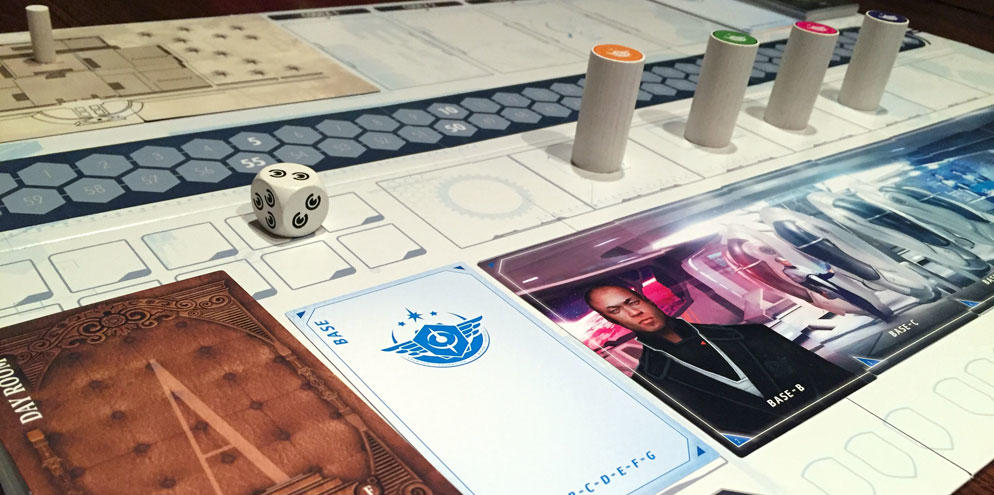 Note: This will be a spoiler free review of TIME Stories.
Note: This will be a spoiler free review of TIME Stories.
The year was 1993. Bill Murray captured audience’s attention with a fantastic comedy called Groundhog Day. In this cult classic, Phil (played by Bill Murray) was forced to repeat his day over and over until he finally figured out how to get out of the loop. This concept was later repeated in a movie called Edge of Tomorrow (I called it SciFi Groundhog Day) and also Source Code. It was a brilliant concept back in 1993 and remains so today.
Recently, young publishers Space Cowboys released a game called TIME Stories. This rather unique board game borrows from the premise of these great movies and sends players through a looping series of games. In TIME Stories, players are temporal agents who travel back in time to accomplish a specific mission. However, unless you are very lucky, chances are it will take you more than one game to achieve your goals. Does this looping mechanic work on our tabletop? Let’s dive in and find out.
TIME Stories is a Cooperative deduction game for 2-4 players that takes about 60-90 minutes to play. In my experience, TIME Stories plays best with 4 players.
Game Overview:
TIME Stories is a scenario based deduction game, so every “series” of games you play will be different. However the base game comes with only one mission in the box (Asylum), so chances are you’ll be playing that one first.
At the start of every game, players are given a briefing that outlines the overall mission goal. Each player takes on the role of a unique character during the mission (called a receptacle), each with their own stats and special skills.
During the game, players will be traveling around the different locations, encountering characters, solving puzzles, and sometimes fighting battles. The game’s progress is tracked via Time Units (TUs). Players must complete their mission before the TU tracker reaches zero or the game ends in failure.
Game Components:
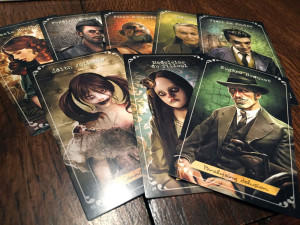
Much like most of Space Cowboys titles, the components in TIME Stories are pretty solid. The action is centralized on a large game board that has a few different spaces to house the game’s various components. The main component of each game is the mission deck. This is usually comprised of separate sections of cards including: Home base, mission map, receptacles, items, information cards, and location cards. Players will work though these different decks as they run through the game, uncovering more pieces of the puzzle.
The game also includes a variety of cardboard tokens and wooden player markers with stickers
The two things I want to make note of are the insert and rulebook. Once again Space Cowboys has designed a custom insert to hold all the game’s pieces. While the insert in Splendor, Black Fleet, and Elysium were all very well done, the TIME Stories insert was a bit of a let down. Not only do the compartments do a poor job of holding your components (can barely get the time tracker out of the plastic well), but the plastic is very thin and breaks quite easily. It was a great idea that just failed in execution.
Finally, the rulebook leaves a little to be desired. We found that we were left with more than a few questions on how to play the game, especially in the order in which we take actions. It wasn’t the most intuitive and led to multiple debates during the game. Thankfully, others on the internet have banded together and compiled an unofficial FAQ that clears some things up. I’ve also heard rumblings that Space Cowboys is going to be releasing an updated rulebook that will be much easier to learn from (fingers crossed).
How to Play:
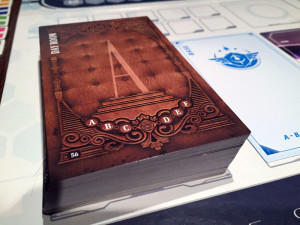
The game always starts in the home base with a mission briefing. After that, players choose their receptacles and are sent out on the mission.
To avoid spoilers, I’ll be brief on the how to play. TIME Stories is played over a series out rounds. Players always start at one location and may move to others on later turns.
Arriving at a location:
Each player chooses which card in the panorama they wish to examine. They flip over the card and read the information on the back. This is a free action.
After that, each player chooses their action, one of three possibilities:
1. Move to another card – There are usually a few different cards in the Panorama and players may move to a different one as an action. Once they move, they can flip over the card and read the information on the back. Note: the game says that players should not read the card out loud, but they may summarize the info on it.
2. Make a Characteristic Roll: The tests in TIME Stories are fairly easy to understand. Players gather a number of dice based on the characteristic being tested and roll them. Every test will have a number of shields, some with special icons. For each hit symbol, the players remove a shield (from left to right). Sometimes, as in the case of a fight, they may take damage if there are danger shields and the players roll a skull. If all the shields are gone after a roll, the test is overcome and the players gain the listed reward (if any). If shields still remain, players may continue to fight the test on later rounds.
3. Do Nothing – This won’t happen often, but players have the option of just hanging out and doing nothing.
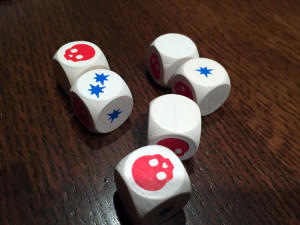
Each player gets to perform an action for the round and it costs the group 1TU. Players may repeat action rounds until they are ready to move on to another location. Once they do, they move their pawn on the map to the new location and roll the TU die. This move will cost them anywhere from 1-3 TUs.
And that’s the basic overview of how to play the game. Mind you along the way players will be discovering locations, gaining clues and items, and solving puzzles. If the TU tracker reaches the last space before players accomplish their goal, the run ends and it’s game over.
This is where TIME Stories is unique compared to other games. If the players wish to have another go at accomplishing their mission, the game is reset back to it’s starting state (for the most part) and players may try again. However, this time they will have the knowledge of the cards they’ve seen already and can make wiser decisions.
Once the players accomplish their mission, they are scored based on how well they did.
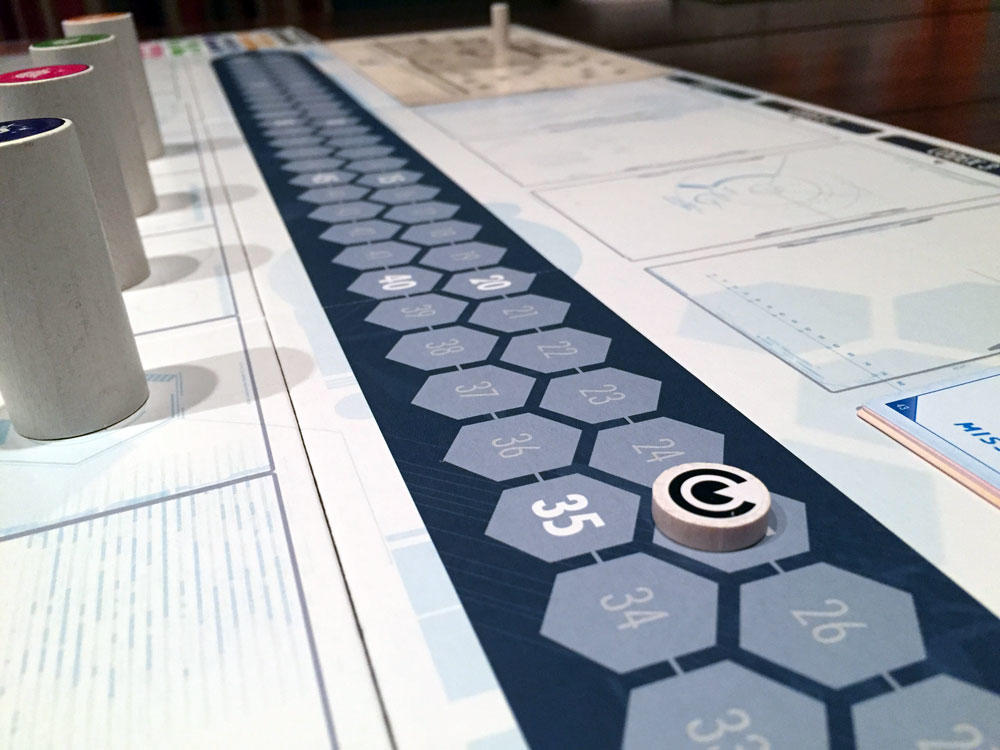
Game Experience:
Much like Pandemic: Legacy, TIME Stories has had its fair share of controversy. This is due to it’s scenario based nature and each mission’s limited replay value. I wrote an article on this a few weeks ago, so you can check that out for my thoughts on this craziness. Regardless of people’s thoughts on how games “should be played”, it’s true that you will only play each mission until you solve it, and then it is most likely doomed to collect dust (or in the case of expansion, land in the trade pile).
So the big question is if it’s worth it. Does the game experience provide enough satisfaction to make up for its limited replay value. To that, I say the answer is a resounding YES.
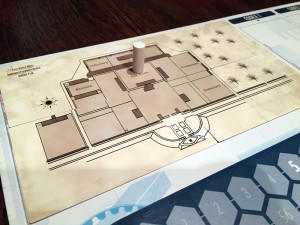
I REALLY enjoyed TIME Stories. From the Groundhog Day like game mechanics, to the overall narrative, to the “locked room” puzzle nature of the game. Everything about it was entertaining, well done, and left me yearning for more.
The scenario included in the base game, Asylum, definitely felt a bit like a training wheels mission. Many concepts were introduced to the players slowly over the course of the game, which I liked. It allowed for minimal rules explanation up front and let players jump in on the action.
One of the interesting things about TIME Stories is how players are almost doomed to always lose their first game. Unless you are extremely lucky, chances are you won’t win the first time through. While that may be a problem for some (one of our players didn’t like that she couldn’t win on the first try), I had no issues with it. In fact, I really treat the whole mission itself as one “game”. Whether it takes you 3 runs or 10 to get through a mission, chances are you are going to want to do it all with the same group anyway.
The downfall of that is it can be hard to get the mission completed in one session. If you have trouble getting players back to the gaming table like I do, who knows how long it could take to finally finish the mission.
But it really helps to have the same players each game (at least per mission) due to the revealing nature of the game. As players slowly learn more about what’s at each location, they will eventually figure out the optimal routes, which items are needed, and which dead ends to avoid (hint: all of them).

In fact, since the rules didn’t explicitly forbid it (I’m not even sure if it’s frowned upon by the designers), we took notes at each location. To be honest, solving the mystery would be incredibly difficult if we hadn’t. There is just so much to try to remember.
I should point out though that the dice aspect of the game wasn’t my favorite. I get why it’s in there, to keep players on their toes and add a bit of unpredictability. But there were times we had a perfect (so we thought) plan laid out and the dice just hated us. It was a little disheartening to see great plans set by the wayside due to crappy rolls. As those TUs floated away, I couldn’t help but curse the dice.
However, once you solve the mission, it can be incredibly satisfying. There is a great sense of both teamwork and accomplishment when you finish a mission. Of course, the down side is that once you do finish the mission, there isn’t much else to do with the game until you get the next one. With the expansions clocking in at $20-$30, that’s a bit of a steep price for a one time use expansion. I could see a thriving trade market developing for TIME Stories once a bulk of expansions are released.
I should note that Space Cowboys has released a scenario designer’s kit for free on their website. This provides all the tools and imagery a player needs to create their own scenario. It still remains to be see how many fans will go through the trouble of both designing and play-testing a scenario, but here’s hoping that number is a high one.
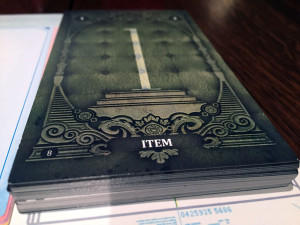
I mentioned earlier that you want to play TIME Stories with the same people (at least for each mission). This did make it a bit difficult to test player scaling in the game, so I waited until I picked up the first expansion, The Marcy Case, to write this review. We played the base game with 4 players and the The Marcy Case with 2 players.
In general, I like the game better with 4. You have more heads working on the mission and the narrative works a little better because you don’t exactly know what’s on every card (if you play by the rules and don’t show off every card).
But despite rumblings I heard online, I think the game also plays fine with 2 players. Normally I abhor games that make you control 2 characters when you don’t have enough players (Sentinels of the Multiverse I’m looking at you). Usually its just too much to handle during the game and the experience is sub-optimal. But in TIME Stories, most of the characters have only minor differences. It really didn’t affect our enjoyment of the game. In fact, my wife said she actually preferred playing it with 2 as there was less a chance of a player taking on the Alpha role and running the game. She also preferred to read cards herself rather than hear about them.
Final Thoughts:
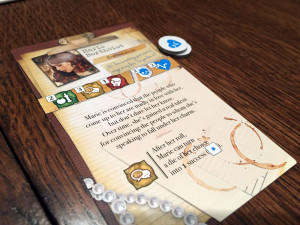
TIME Stories was a home run in my book. I’m going to be instantly picking up every expansion that is released for this game, which can’t come soon enough as far as I’m concerned!
While the price of the expansions aren’t cheap, I think the unique game play and entertaining gaming experience can help make up for it. I do wish they were a little cheaper though, especially after seeing what’s included the box.
Even still, I’d say we spent probably 5-6 hours on each mission after all of our failed attempts and I enjoyed every minute of it.
If you are someone who enjoys puzzles, thinking outside the box, or even if you are just looking for a unique gaming experience then absolutely give TIME Stories a try. It was one of my top 3 games from 2015 and I can’t wait for the next expansion to be released. TIME Stories will be hitting my gaming table as often as Space Cowboys gives me a reason for it. Bring on the missions!
If you’d like to pick up a copy of TIME Stories, you can get it for about $40.
Final Score: 4.5 Stars – A unique and highly entertaining deduction game that can be quite addictive. If only there were more missions.
 Hits:
Hits:
• Unique and engaging gameplay
• Highly thematic missions
• Cooperative choose-your-on-adventure style game play
• Easy to learn mechanics
Misses:
• Only one mission included and the price for expansions could be better.
• No replay value after finishing a mission
• Rulebook needs some help.








